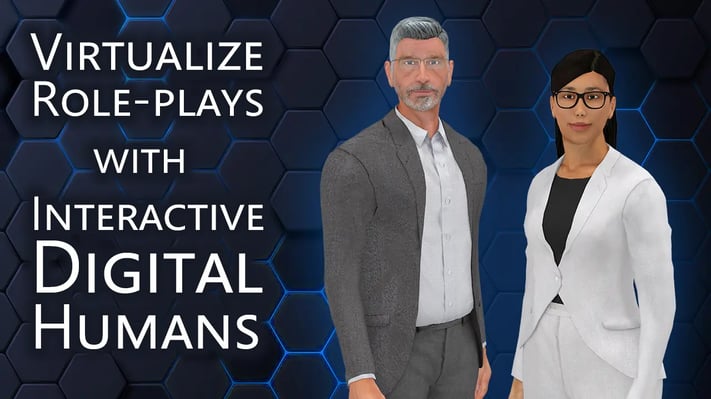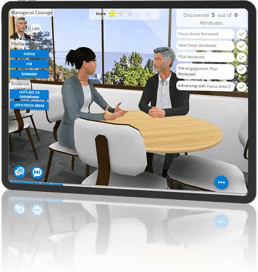
Yes, peer-to-peer training role-plays can be a bit awkward. What if we could immerse trainees in situational decisions with interactive digital humans instead? And what if we could combine these virtual interactions with skill development methodologies, and analytics? In this article we will explore doing just that. We will cover: when skill development is important, the advantages of virtualizing role plays, how the underlying technology works, and the steps to build your own virtualized role plays.
Let’s get started…
When Skill Development is Important to Achieve Training Goals
Training programs are great at imparting knowledge, such as new processes, new ways to interact with others, or new ways to think. What is challenging is giving trainees the skill and confidence to actually use this new knowledge in real situations: that is, changing their behavior.

Skill development drives and accelerates adoption of training strategies and is part of the adult learning continuum.
Time and time again, training organizations struggle to see results in new training initiatives that don’t have a skill-development component. Why? When the training involves many variables, nuance, or a high-stakes decision (with the potential for embarrassment), trainees are less likely to apply what they learned, because they lack both the competence and the confidence to do so. The result: no change in behavior.
Practicing in realistic situations with expert corrective coaching is a proven methodology to develop skills.1-8 It’s been successfully used across disciplines from aviation to athletics, in the arts, technical trades, medicine, learning and development, and sales.
Wouldn’t it be great to practice applying your training in role plays with an expert mentor? Yes! Unfortunately, a peer-to-peer role-play at the end of training lacks both realism and the expert, coaching feedback needed to accelerate skill acquisition. But all is not lost. Through technology, we can emulate realistic situational decision-making and expert coaching feedback in a “virtualized role play.” We can accomplish this using digital humans, interactive game technology, and the cognitive science around skill acquisition to create a targeted, safe environment to learn by doing.
5 Advantages of a Virtualized Role Play
Let’s dive into the five advantages of virtualizing role plays with digital human technology, to develop skill, change behaviors, and improve performance. (Check out the video for a quick demonstration of a virtualized role play.)

1) Scalable. Practice with one-on-one coaching is the proven way to accelerate skill acquisition. Coaches and managers can role play with trainees to safely practice using new knowledge optimally. But coaches are often in short supply and expensive to scale, while managers have limited time and uneven coaching skills. By virtualizing these role-plays with digital humans and skill-driven learning frameworks, this pull-through can be done at scale, freeing up coaches and managers to do more personalized mentoring.
2) Immersive Engagement. By combining game technology and skill development methodologies, we immerse trainees in realistic situations with digital humans, where they make decisions and receive personalized feedback on each choice. The digital humans are available 24/7, and can be programmed to respond intelligently, using your language, your talk tracks, and your coaching. Therefore, unlike a passive video, the trainee is gaining experience making decisions, receiving coaching to optimize their mental models, and gaining confidence through practice.

3) Consistent. Another advantage of virtualized role plays, is that trainers can capture the best role-play scripts and coaching feedback from internal experts once, and then deliver it broadly. This allows all learners to obtain a consistent hands-on experience where they practice closing known performance gaps. This alleviates the concern that there are not enough coaches to pull through the training, or that managers may vary in time, motivation, and expertise to do the skill development.
4) Measurable Performance. As learners make decisions, the personalized corrective coaching feedback they received is captured. This data shows which situations they struggled with the most before recognizing an optimal path, and what suboptimal or inappropriate choices were the most common before corrective coaching. This analysis can inform on existing and future training strategies.
5) Translation Friendly. Utilizing artificial intelligence (AI) technologies for translation and voice, it’s possible to cost-effectively adapt a virtualized role play into other languages. Machine learning can substantially reduce the cost of translation, and neural voices created via AI can power digital humans in any language.
How Virtualized Role Play Technology Works
 Use of Artificial Intelligence (AI). To have a digital avatar interact appropriately with a trainee, one would need an AI that understands contextual language. (Even Siri struggles mightily with that.) On top of that, the AI would need to be trained to understand your company’s relevant processes and the best coaching in context. This leading-edge technology is just now being applied in narrow use-cases, and is therefore not a fit for customized training (or the budget!). That’s why a scripted AI approach is the most reasonable approach for training. That is, the interactive AI logic and dialogue is scripted by humans that know the content. Scripted AI is what video games have done for decades, and it's the approach used by chatbots.
Use of Artificial Intelligence (AI). To have a digital avatar interact appropriately with a trainee, one would need an AI that understands contextual language. (Even Siri struggles mightily with that.) On top of that, the AI would need to be trained to understand your company’s relevant processes and the best coaching in context. This leading-edge technology is just now being applied in narrow use-cases, and is therefore not a fit for customized training (or the budget!). That’s why a scripted AI approach is the most reasonable approach for training. That is, the interactive AI logic and dialogue is scripted by humans that know the content. Scripted AI is what video games have done for decades, and it's the approach used by chatbots.

The Realistic Conversation. A one-sided conversation with an avatar is often proposed as the solution. A three-way dialogue between two digital humans, interacting with each other and the trainee is much more ideal. This approach allows the trainee to see what suboptimal interactions look like, as well as great conversations that are based on their own decision-making. Finally, we also want a conversational virtual coach that provides nuanced feedback on the decision-making that emulates what an expert human coach would say. Creating this conversation engine in software involves 100s of animations, voice processing, gestures, and decision logic, all within a framework that can be customized to any type of dialogue.
How to Get Started Creating Virtualized Role-plays
An effective virtual role play emulates what an expert coach would do. The AliveSimTM platform achieves this using a scalable approach, and a tried and tested development process.
Here’s a three-step process that we use to construct virtualized role plays with customers.
- Decide on the focus of the role-play scenarios. Prioritizing performance gaps within a specific topic is a good starting point. Which gaps have the greatest impact on the organization? Which performance gaps are the most nuanced or challenging to master? What traditional training is not yielding the changes in behavior, and can benefit from adding a skill-driven component? We have processes to help identify and prioritize performance gaps if needed.
- Design Stage. Any existing assets are a good starting point, including role-play scripts, knowledge-based training curriculum materials, and any associated visuals. At Syandus, we have developed a process to facilitate the best-practice design of decision points, and how to extract coaching feedback from your in-house subject matter experts. Finally, capturing the transcript from informal role play examples on a web call, can capture company language, coaching approaches, and what great sounds like. These assets can then be used to design effective decisions, integrate coaching, and develop an overall flow and scope of the role-play.
- Configure the simulation. Our team uses templates to add the content into the AliveSim platform, including conversational dialogue based on existing scripts, decision logic, coaching feedback, and images. Choose 3D environments and digital humans from the AliveSim library. The experience is brought to life via animation, voice, gestures, interactive decisions, embedded AI, responsive feedback, gamification, and other immersive components.
Launch, measure, modify, translate. Now it’s time to put the digital humans to work! A simple link allows trainees to access the module on any device, through a modern web browser. Analytics are available 24/7 after launch, to gain insights from performance. Down the road, the templates can be modified with changes, cloned to make new modules faster, or translated with AI-generated voices for global reach.
Final Thoughts
Virtualized role plays with digital humans can add an engaging, scalable skill development component to drive meaningful behavior change. Proven skill development methodology involves identifying performance gaps, and having expert coaches set up situations and personally mentor learners through their decisions. This is expensive and difficult to scale in practice. Software engineering solutions, like AliveSim, can provide a surrogate environment to implement skill-driven learning, at scale, in training initiatives. As a bonus, learner decision data is captured for insightful outcomes reporting.
References
- Theoretical Foundations of Learning Environments. D. Jonassen and S. Land, editors, Routledge, 2012.
- Larson, Kristine M.. “Serious Games and Gamification in the Corporate Training Environment: a Literature Review.” TechTrends 64 (2019): 319-328.
- Kalmpourtzis, G. (2018). Educational Game Design Fundamentals: A Journey to Creating Intrinsically Motivating Learning Experiences (1st ed.). A K Peters/CRC Press.
- Anders Ericsson, K., Deliberate Practice and Acquisition of Expert Performance: A General Overview. Academic Emergency Medicine, 2008;15: 988-994. https://doi.org/10.1111/j.1553-2712.2008.00227.x
- Collins, Allan, John Seely Brown, and Ann Holum. Cognitive apprenticeship: Making thinking visible. American educator 15.3 (1991): 6-11.
- Stalmeijer, R.E., Dolmans, D.H.J.M., Wolfhagen, I.H.A.P. et al. Cognitive apprenticeship in clinical practice: can it stimulate learning in the opinion of students? Adv in Health Sci Educ 2009;14, 535–546. https://doi.org/10.1007/s10459-008-9136-0.
- Kolb D. Experiential Learning: Experience as the source of learning and development. Prentice Hall, Upper Saddle River, NJ. 1984.
- Spiro, Rand J., et al. "Cognitive Flexibility Theory: Hypermedia for Complex Learning, Adaptive Knowledge Application, and Experience Acceleration." Educational technology 43.5 (2003): 5-10.
About Syandus: Virtual immersive learning technology that transforms knowledge into real-world performance. We immerse participants in realistic virtual situations with one-on-one expert coaching that gives them experience making optimal decisions. Syandus Learning Modules combine cognitive science principles, the realism of game technology, and our customer’s proprietary content, to deliver rapid skill acquisition. Modules are cloud-based for easy deployment, fully trackable with embedded analytics, and can be used on any web-enabled device.



